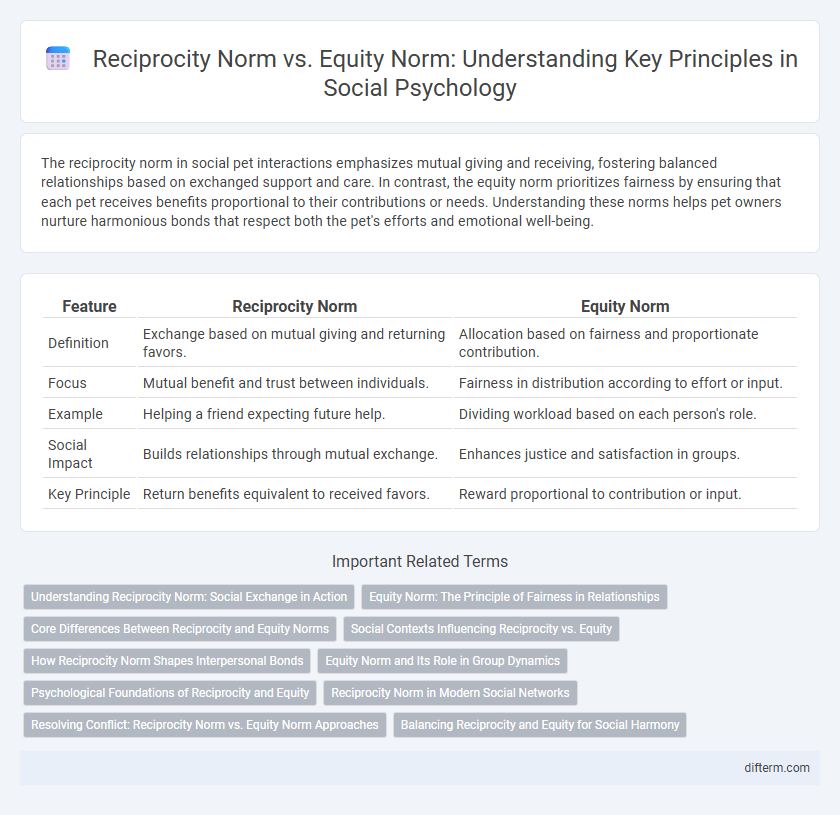The reciprocity norm in social pet interactions emphasizes mutual giving and receiving, fostering balanced relationships based on exchanged support and care. In contrast, the equity norm prioritizes fairness by ensuring that each pet receives benefits proportional to their contributions or needs. Understanding these norms helps pet owners nurture harmonious bonds that respect both the pet's efforts and emotional well-being.
Table of Comparison
| Feature | Reciprocity Norm | Equity Norm |
|---|---|---|
| Definition | Exchange based on mutual giving and returning favors. | Allocation based on fairness and proportionate contribution. |
| Focus | Mutual benefit and trust between individuals. | Fairness in distribution according to effort or input. |
| Example | Helping a friend expecting future help. | Dividing workload based on each person's role. |
| Social Impact | Builds relationships through mutual exchange. | Enhances justice and satisfaction in groups. |
| Key Principle | Return benefits equivalent to received favors. | Reward proportional to contribution or input. |
Understanding Reciprocity Norm: Social Exchange in Action
The reciprocity norm governs social exchange by encouraging individuals to return favors and maintain balanced interactions, fostering trust and cooperation within communities. Unlike the equity norm, which emphasizes proportional fairness based on inputs and outcomes, reciprocity centers on mutual benefit and the expectation of future exchanges regardless of exact equivalence. This dynamic drives social cohesion by reinforcing positive relationships through ongoing, reciprocal support.
Equity Norm: The Principle of Fairness in Relationships
Equity norm emphasizes fairness by ensuring that resources, effort, and rewards in relationships are distributed based on individual contributions, promoting balance and mutual respect. Unlike the reciprocity norm, which focuses on immediate exchange and return favors, equity norm fosters long-term satisfaction by valuing proportionality and justice in interpersonal interactions. This principle supports stable and equitable relationships by aligning expectations with personal input and effort.
Core Differences Between Reciprocity and Equity Norms
Reciprocity norm centers on mutual exchange where individuals respond to others' actions with similar behavior, fostering cooperation and trust in social interactions. Equity norm emphasizes fairness based on proportionality, where rewards and contributions are balanced to ensure equal outcomes relative to inputs. The core difference lies in reciprocity's focus on reciprocal actions while equity prioritizes proportional fairness in resource distribution.
Social Contexts Influencing Reciprocity vs. Equity
Social contexts influence the application of reciprocity and equity norms by shaping expectations of fairness and obligation within relationships. Reciprocity norms dominate in close-knit or communal settings where mutual exchange fosters trust and social bonding. Equity norms are more prevalent in formal or transactional contexts, emphasizing proportional distribution based on individual contributions or inputs.
How Reciprocity Norm Shapes Interpersonal Bonds
The reciprocity norm fosters interpersonal bonds by encouraging mutual exchanges of favors and support, reinforcing trust and cooperation between individuals. This norm activates a cycle of giving and receiving that strengthens social ties and creates a sense of obligation to maintain positive relationships. Its emphasis on balanced interactions promotes ongoing social cohesion and emotional connection within groups.
Equity Norm and Its Role in Group Dynamics
Equity norm emphasizes fairness based on proportional contributions and rewards within a group, fostering motivation and accountability among members. In group dynamics, equity norm helps maintain balance by ensuring individuals receive outcomes aligned with their inputs, which supports sustained cooperation and reduces resentment. This norm plays a crucial role in team performance, as perceptions of equity influence members' commitment and overall group cohesion.
Psychological Foundations of Reciprocity and Equity
The psychological foundation of the reciprocity norm is rooted in the innate human tendency to respond to positive actions with similar behavior, fostering mutual cooperation and social bonding. In contrast, the equity norm is based on the principle of fairness, where individuals expect outcomes proportional to their contributions, emphasizing balance and justice in social exchanges. Both norms play crucial roles in shaping interpersonal relationships and social cohesion by guiding expectations and behavior in cooperative interactions.
Reciprocity Norm in Modern Social Networks
Reciprocity norm in modern social networks promotes mutual exchange of support, information, and favors among users, reinforcing trust and cooperation within digital communities. This norm facilitates sustained interactions through mechanisms like likes, comments, and shares, which reward users and encourage ongoing contribution. Unlike equity norm, which emphasizes proportional fairness, reciprocity norm relies on balanced give-and-take relationships, crucial for building social capital in platforms such as Facebook, LinkedIn, and Twitter.
Resolving Conflict: Reciprocity Norm vs. Equity Norm Approaches
Resolving conflict through the reciprocity norm emphasizes mutual exchange and balancing benefits to restore harmony, fostering cooperation based on return favors. The equity norm approach focuses on fairness by ensuring that contributions and rewards are proportionate, minimizing feelings of injustice among parties. Combining both norms can enhance conflict resolution by addressing both relational balance and individual fairness needs in social interactions.
Balancing Reciprocity and Equity for Social Harmony
Balancing reciprocity and equity norms is crucial for social harmony, as reciprocity emphasizes mutual exchange of benefits while equity focuses on fairness based on contribution. Maintaining a dynamic interplay between these norms helps prevent conflicts by ensuring that social interactions are both balanced and just. Societies that effectively integrate reciprocity with equity tend to foster stronger trust and cooperation among members.
reciprocity norm vs equity norm Infographic

 difterm.com
difterm.com